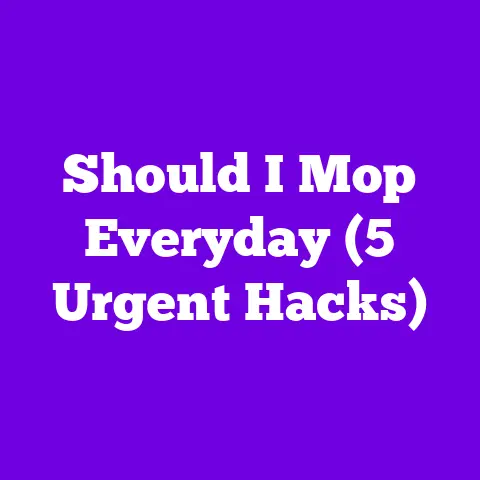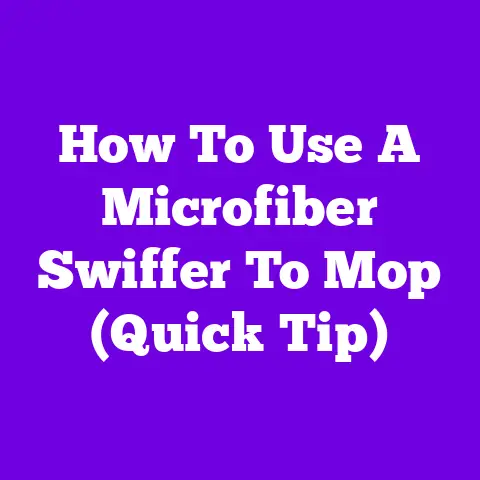How To Make Replacement Pads For Steam Mop (3 Fast Fixes)
“I’ve always believed that if you take care of your floors, they’ll take care of you,” says Sarah MacDonald, a professional cleaner with over 20 years of experience.
Hey there! Ever had one of those days where your steam mop pads are just not doing their job anymore? I sure have. Replacing them can be a bit of a hassle, but making your own can save a ton of money and time. So, let’s dive into how you can whip up some replacement pads for your steam mop quickly and efficiently.
Why Make Your Own Steam Mop Pads?
You might be wondering why you’d even bother making your own pads. Well, here are a few good reasons:
- Cost-Effective: Store-bought pads can be pricey.
- Custom Fit: You can make them fit just right.
- Sustainability: Reusing materials is better for the planet.
A Personal Story
Let me share a quick story. One day, I ran out of steam mop pads just before a big family gathering. With no time to hit the shops, I improvised with some old towels. The results surprised me! Not only did the towels work well, but they also sparked the idea to create my own pads regularly. Since then, I’ve explored various materials and methods, discovering what works best.
Materials You’ll Need
Before we get started, gather these materials:
- Microfiber cloths or old towels
- Scissors
- Sewing machine or needle and thread
- Measuring tape
- Velcro or elastic (optional)
Additional Tools
- Fabric marker or chalk for marking measurements
- Pins to hold fabric in place while sewing
- Safety goggles (if cutting thick materials)
- Cutting board (to avoid damaging surfaces)
Method 1: Microfiber Magic
Microfiber cloths are great for cleaning, and they make fantastic steam mop pads. Here’s how to transform them into reusable pads.
Step 1: Measure Your Mop Head
- Use your measuring tape to get the length and width of your mop head.
- Add an extra inch to each side for seam allowance.
- Consider the thickness of the microfiber cloth when measuring.
Step 2: Cut the Microfiber Cloth
- Lay the microfiber cloth flat.
- Mark your measurements with a fabric marker or chalk.
- Cut out the shape carefully using sharp scissors.
Step 3: Sew the Edges
- Fold the edges over by half an inch and sew them down neatly.
- This prevents fraying and gives a neat finish.
- Use a zigzag stitch for added durability.
Step 4: Attach Velcro or Elastic
- To secure the pad to the mop head, sew Velcro strips on the sides or attach a piece of elastic around it.
- Test the fit on your mop to ensure it stays put and adjust if necessary.
Helpful Tip: Wash the microfiber cloth before use to remove any manufacturing residue that might affect its performance.
Common Mistake: Cutting without measuring accurately. Always double-check before you cut to avoid wastage!
Advanced Tips
- If you’re into sewing, consider adding a second layer of microfiber for enhanced absorption.
- Use contrasting thread colors for style and easy identification.
Method 2: Towel Transformation
Got some old towels lying around? They can be perfect for this task.
Step 1: Select a Towel
- Choose a towel that’s thick enough to withstand steam but not too bulky.
- Consider color-coding your towels for different rooms or cleaning tasks.
Step 2: Measure and Cut
- Just like with microfiber, measure your mop head accurately.
- Cut the towel accordingly, allowing for seam allowance.
- Use pins to secure the fabric while cutting for precision.
Step 3: Sew the Sides
- Fold over the edges and sew them down securely.
- Make sure to double stitch for extra durability.
- Consider adding decorative stitches for a personalized touch.
Step 4: Secure with Velcro
- Use Velcro strips to attach the pad to your mop head.
- This makes removal and washing easy.
- Ensure Velcro is placed symmetrically for balanced cleaning.
Helpful Tip: Use colorful towels to easily distinguish between clean and used pads, preventing mix-ups during cleaning.
Common Mistake: Using thin towels that don’t absorb steam well. Choose wisely!
Advanced Tips
- Experiment with different towel textures to see which cleans best on specific floor types.
- If you have pets, opt for towels with higher absorption rates to tackle pet messes efficiently.
Method 3: No-Sew Quick Fix
If sewing isn’t your thing, here’s a no-sew method using old socks!
Step 1: Find Suitable Socks
- Look for thick, long socks that can cover your mop head completely.
- Consider using mismatched socks to give them a new purpose instead of discarding them.
Step 2: Slide Over Mop Head
- Simply slide the sock over the mop head.
- Adjust so it fits snugly without slipping during use.
Step 3: Secure with Elastic Bands
- Use rubber bands or hair ties to hold the sock in place firmly.
- Make sure it’s tight enough to stay during mopping but not so tight that it damages the sock or mop head.
Helpful Tip: Rotate socks regularly to ensure even wear and extend their lifespan.
Common Mistake: Not securing the sock well. It could slip off during use if not tight enough, causing frustration and potential damage.
Advanced Tips
- Consider using knee-length socks for larger mop heads to ensure complete coverage.
- For added cleaning power, spray a light mist of cleaner onto the sock before mopping.
Proper Cleanup and Finishing
After each use, toss your homemade pads in the washing machine. Use a gentle cycle with mild detergent. Hang them to dry or tumble dry on low heat to prevent shrinkage and maintain their shape.
Additional Cleaning Tips
- For stubborn stains on pads, pre-soak in warm water with a bit of vinegar.
- Avoid using fabric softeners as they can reduce absorbency over time.
Safety Considerations
Always ensure your steam mop is unplugged while attaching or removing pads. Avoid using pads that are too thick, as they may not allow steam to penetrate properly.
More Safety Tips
- Check your homemade pads regularly for wear and tear that could lead to ineffective cleaning or damage to floors.
- If using elastic bands, ensure they do not have sharp edges that could scratch flooring surfaces.
FAQ Section
Q1: Can I use any fabric for making steam mop pads?
A1: It’s best to use absorbent fabrics like microfiber or cotton towels. Avoid materials that might melt or are too thin as they may not withstand steam.
Q2: How often should I replace or wash my homemade pads?
A2: Wash them after each use to maintain hygiene and efficiency. Replace when they start to wear out or lose their effectiveness, typically after several washes depending on material quality.
Q3: Are these DIY pads safe for all floor types?
A3: Yes, but always check your steam mop’s manual for specific floor recommendations. Some floors may require specific cleaning methods or materials.
Q4: What’s the benefit of making my own pads over buying them?
A4: Making your own pads is cost-effective, customizable, and environmentally friendly. You can tailor them to fit perfectly and reuse materials from around the house.
Q5: Can I add essential oils or cleaning solutions to homemade pads?
A5: Yes, but do so sparingly. Some floors may react negatively to certain substances, so always test in an inconspicuous area first.
So there you have it! Making replacement pads for your steam mop is simple, fun, and saves money. Give it a try, and you’ll never look back at store-bought pads again. Got any questions or need more tips? Just let me know!






